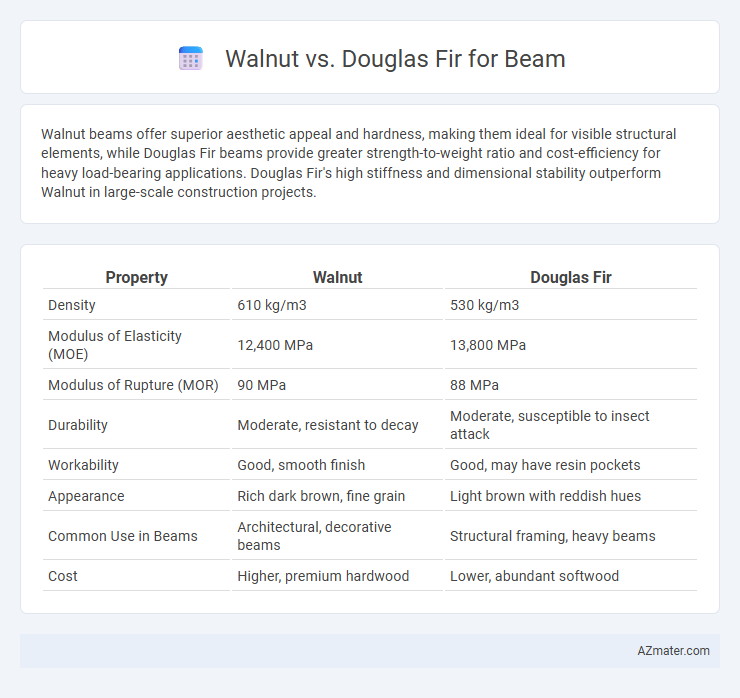Walnut beams offer superior aesthetic appeal and hardness, making them ideal for visible structural elements, while Douglas Fir beams provide greater strength-to-weight ratio and cost-efficiency for heavy load-bearing applications. Douglas Fir's high stiffness and dimensional stability outperform Walnut in large-scale construction projects.
Table of Comparison
| Property | Walnut | Douglas Fir |
|---|---|---|
| Density | 610 kg/m3 | 530 kg/m3 |
| Modulus of Elasticity (MOE) | 12,400 MPa | 13,800 MPa |
| Modulus of Rupture (MOR) | 90 MPa | 88 MPa |
| Durability | Moderate, resistant to decay | Moderate, susceptible to insect attack |
| Workability | Good, smooth finish | Good, may have resin pockets |
| Appearance | Rich dark brown, fine grain | Light brown with reddish hues |
| Common Use in Beams | Architectural, decorative beams | Structural framing, heavy beams |
| Cost | Higher, premium hardwood | Lower, abundant softwood |
Introduction to Walnut and Douglas Fir Beams
Walnut beams offer rich, dark tones and exceptional durability, making them ideal for high-end architectural applications where aesthetic appeal is crucial. Douglas Fir beams are renowned for their strength, straight grain, and affordability, frequently used in structural framing and construction projects. Both woods provide unique benefits, with Walnut excelling in visual warmth and Douglas Fir favored for its robust load-bearing capacity.
Wood Characteristics: Walnut vs Douglas Fir
Walnut features a rich, dark brown color with a fine, straight grain, offering exceptional hardness and durability, making it ideal for decorative beams where aesthetics matter. Douglas Fir exhibits a lighter, reddish-brown hue with a pronounced, straight grain and excellent strength-to-weight ratio, preferred for structural beams due to its superior load-bearing capacity. While Walnut provides superior resistance to wear and decay, Douglas Fir offers greater stability and is more cost-effective for large-scale construction projects.
Structural Strength and Load-Bearing Capacity
Walnut typically has a Janka hardness of around 1,010 lbf, but its structural strength and load-bearing capacity for beams are generally lower than Douglas Fir, which boasts a higher strength-to-weight ratio with a Janka hardness of approximately 660 lbf yet superior mechanical properties like a bending strength of about 12,000 psi compared to Walnut's roughly 8,000 psi. Douglas Fir's stiffness and durability make it the preferred choice for heavy load-bearing applications and long-span beams, providing reliable support in construction frameworks. Walnut beams are better suited for aesthetic or decorative purposes rather than primary structural elements due to their lower modulus of elasticity and strength values.
Durability and Longevity Comparison
Walnut beams offer moderate durability with a Janka hardness of 1,010, making them suitable for decorative applications but less ideal for structural use in high-stress environments. Douglas Fir, with a Janka hardness of 660 and exceptional strength-to-weight ratio, is renowned for its superior durability and longevity in heavy structural applications, resisting bending and wear over time. While Walnut provides aesthetic appeal and moderate lifespan indoors, Douglas Fir outperforms in longevity and durability for load-bearing beams exposed to variable conditions.
Appearance and Aesthetic Appeal
Walnut beams offer a rich, dark brown color with fine, straight grain patterns that provide a luxurious and warm aesthetic ideal for upscale or rustic interiors. Douglas fir beams feature a lighter, reddish-yellow hue with distinct, pronounced grain that enhances natural and traditional designs through a vibrant, textured look. Both wood types add unique character to beams, but walnut emphasizes elegance while Douglas fir highlights rustic charm and structural prominence.
Workability and Ease of Installation
Walnut offers moderate workability with a smooth finish, but its hardness can require sharper tools and more effort during cutting and shaping compared to Douglas Fir. Douglas Fir is highly regarded for its ease of installation due to its straight grain and softer texture, allowing faster nailing and screwing without splitting. When selecting beams, Douglas Fir typically reduces labor time, while Walnut provides a refined aesthetic but demands more precision in handling.
Cost and Availability Factors
Walnut beams generally cost more than Douglas Fir due to walnut's scarcity and slower growth rate, leading to higher market prices. Douglas Fir is widely available and sustainably harvested, making it a cost-effective option for structural beams. Availability of Douglas Fir in larger dimensions and consistent quality further contributes to its preference in construction projects where budget and supply reliability are critical.
Environmental Impact and Sustainability
Walnut wood, while prized for its rich color and durability, typically has a higher environmental impact due to slower growth rates and less widespread availability compared to Douglas Fir. Douglas Fir is a more sustainable option for beams, as it grows quickly, is abundant in managed forests, and has a lower carbon footprint through efficient carbon sequestration during growth. Using Douglas Fir supports sustainable forestry practices and reduces resource depletion, making it a more eco-friendly choice for construction projects focused on environmental responsibility.
Applications: When to Choose Walnut or Douglas Fir
Walnut beams are ideal for decorative applications where aesthetic appeal and rich color are paramount, such as in luxury interiors, custom cabinetry, and exposed architectural features. Douglas Fir beams offer superior structural strength and cost-effectiveness, making them perfect for load-bearing frameworks, construction projects, and large-scale outdoor applications. Choose Walnut when design elegance outweighs budget constraints, and Douglas Fir when durability and versatility are critical for structural integrity.
Conclusion: Best Choice for Your Beam Project
Walnut offers exceptional strength and rich aesthetics, making it ideal for premium beam applications where visual appeal is prioritized. Douglas Fir provides superior structural integrity and affordability, suiting projects requiring durable and cost-effective beams. Choose Walnut for elegant, high-end beams, and Douglas Fir for robust, budget-friendly structural support.

Infographic: Walnut vs Douglas Fir for Beam
 azmater.com
azmater.com